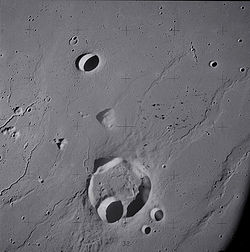 Oblique Apollo 15 image | |
| Coordinates | 30°36′N46°59′W / 30.60°N 46.98°W |
|---|---|
| Diameter | 9.64 km (5.99 mi) |
| Depth | 1.0 km |
| Colongitude | 47° at sunrise |
| Eponym | William H. Wollaston |



Wollaston is a relatively small lunar impact crater located in the Oceanus Procellarum. To the northwest is the similar Nielsen. To the southeast is the somewhat larger Krieger. There are several small rilles to the southwest of Wollaston, forming part of the Rimae Prinz.
Contents
The crater was formally named by the IAU in 1935. [1]
This is a circular, cup-shaped crater with a higher albedo than the surrounding mare. It has a raised rim that is free from impact erosion, and is surrounded by a small radial skirt of ejecta. The crater has not been significantly eroded by subsequent impacts.